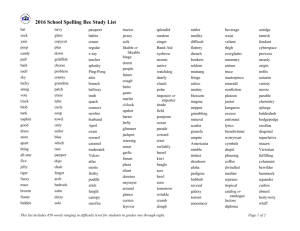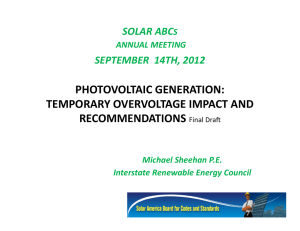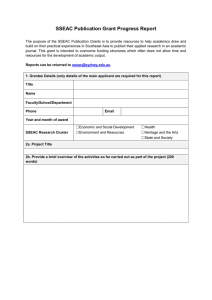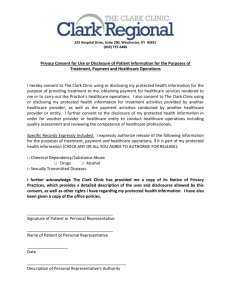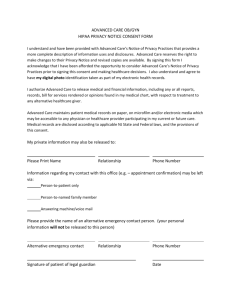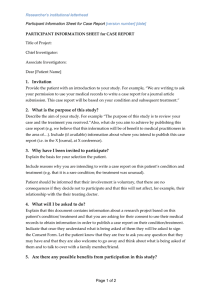Methodology Note regarding the implementation of the EFPIA
advertisement
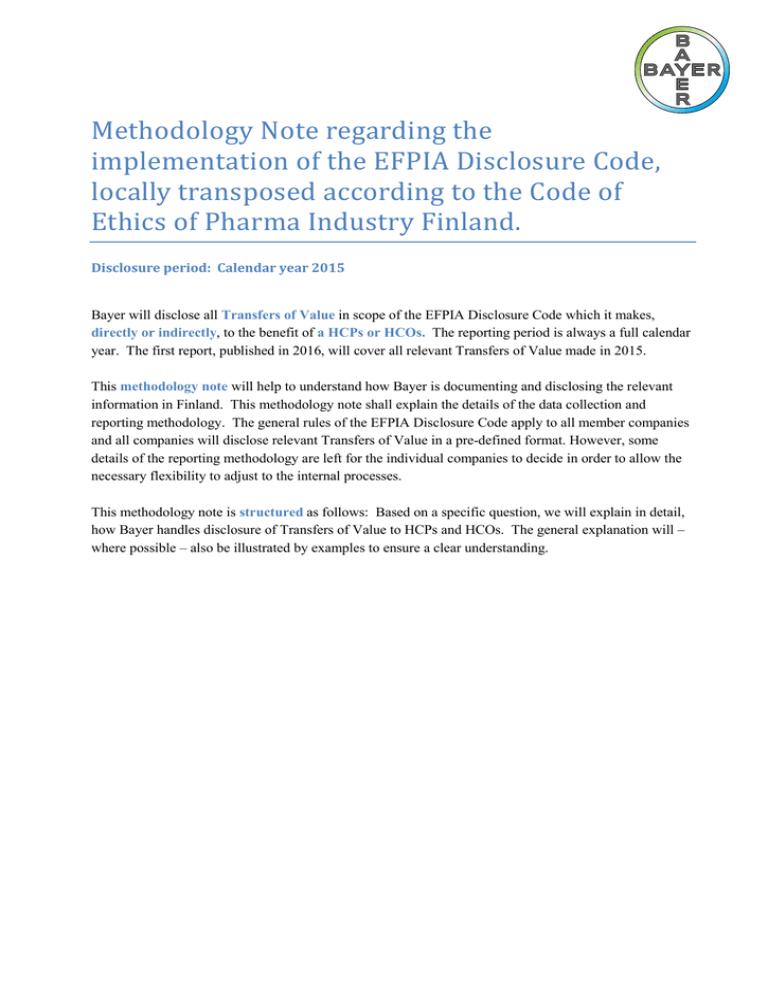
Methodology Note regarding the implementation of the EFPIA Disclosure Code, locally transposed according to the Code of Ethics of Pharma Industry Finland. Disclosure period: Calendar year 2015 Bayer will disclose all Transfers of Value in scope of the EFPIA Disclosure Code which it makes, directly or indirectly, to the benefit of a HCPs or HCOs. The reporting period is always a full calendar year. The first report, published in 2016, will cover all relevant Transfers of Value made in 2015. This methodology note will help to understand how Bayer is documenting and disclosing the relevant information in Finland. This methodology note shall explain the details of the data collection and reporting methodology. The general rules of the EFPIA Disclosure Code apply to all member companies and all companies will disclose relevant Transfers of Value in a pre-defined format. However, some details of the reporting methodology are left for the individual companies to decide in order to allow the necessary flexibility to adjust to the internal processes. This methodology note is structured as follows: Based on a specific question, we will explain in detail, how Bayer handles disclosure of Transfers of Value to HCPs and HCOs. The general explanation will – where possible – also be illustrated by examples to ensure a clear understanding. Contents Disclosure period: Calendar year 2015 ............................................................................................... 1 I. Data Privacy................................................................................................................................... 3 1. Data Privacy – Consent for publication of data............................................................................ 3 2. Data Privacy – Partial consent for publication of data ................................................................. 3 3. Data Privacy – Declaration of Consent ........................................................................................ 4 4. Duration of publication ................................................................................................................ 4 II. General questions .......................................................................................................................... 5 5. Cross-border interactions.............................................................................................................. 5 6. Publication of ToV granted in a foreign currency ........................................................................ 5 7. VAT .............................................................................................................................................. 6 8. ToV connected to product groups which do not solely comprise prescription pharmaceuticals 6 9. Reporting period ........................................................................................................................... 7 10. Publication of ToV relating to contractual arrangements lasting several years ....................... 8 11. Sponsoring payments made to more than one organisation ..................................................... 9 12. ToV to contract research organisations (CROs) ....................................................................... 9 13. Recording of ToV granted to universities and other educational establishments.................. 10 14. Indirect ToV to healthcare professionals and organisations ................................................... 10 15. Transport costs for joint transportation .................................................................................. 11 III. Questions on the report ............................................................................................................... 11 16. Donations –hospitals or clinics as recipients .......................................................................... 11 17. Sponsorships ........................................................................................................................... 12 18. Scientific and educational events – definition ........................................................................ 12 19. Scientific and educational events – attendance fees ............................................................... 12 20. Scientific and educational events – travel and accommodation costs .................................... 13 21. Scientific and educational events – organisation by an events agency .................................. 13 22. Continuous professional development events – costs for internal events .............................. 14 23. Service and consultancy fees – definition .............................................................................. 14 24. Service and consultancy fees – reimbursement of expenses .................................................. 15 25. R&D – definition .................................................................................................................... 15 26. R&D – basic research ............................................................................................................. 16 -2- I. Data Privacy 1. Data Privacy – Consent for publication of data Question What is the importance of HCPs‘ [and HCO’s] consent to the publication of data? Legal Background As the Disclosure Code is a voluntary self-obligation of the pharmaceutical industry, publication of data is dependent on the consent of Healthcare Professionals concerned. In some countries, also healthcare Organizations must consent to the disclosure of data. Everyone is entitled by law to protection of data relating to them. This basic right covers the recording, processing and dissemination of any kind of personal information, whereby any of these shall require the specific consent of the person affected. There are strict requirements for any such consent – it must be explicit, it needs to be visually highlighted in any contractual texts or similar documents and must be clearly and transparently worded. Methodology Bayer is requesting consent from all HCPs [and HCOs] before starting an interaction leading to transfers of value. If such consent is not granted, Bayer will publish the transfers of value only in the aggregated section of the report, without mentioning the name, address or other personal data of the recipient. 2. Data Privacy – Partial consent for publication of data Question How does Bayer react, if a Healthcare Professional, despite our best efforts to reach full consent, only grants partial consent for the publication of selected Transfers of Value? Example This situation may arise, for instance, if a Healthcare Professional consents to the publication of accommodation costs for a congress participation. However, the HCP does not consent to the publication of a speaker fee, which is paid for a speaker engagement at a different point in time. -3- Methodology As Bayer is collecting overall consent (please see question 3), Healthcare Professionals cannot grant consent only for selected transfers of value. However, it is possible that they choose to withdraw consent for selected activities. If this happens, Bayer will report all transfers of value to such Healthcare Professionals in the aggregated section of the report. We believe that reporting only selected Transfers of Value on an individual level decreases the level of transparency by giving a distorted picture. 3. Data Privacy – Declaration of Consent Question What sort of declaration of consent is data processing at Bayer based on? Methodology Bayer is using the following approach to obtain consent from Healthcare Professionals and (where necessary) Healthcare Organizations: Bayer is requesting consent before the first reporting relevant transaction with the respective Healthcare Professional. The Healthcare Professional or Organization is informed about the purpose of the EFPIA Disclosure Code and the required data processing. The Healthcare Professional or Organization can then decide to grant a consent for at least one full reporting period or do dissent to the publication of data. Partial consent is not possible (see question n°2) 4. Duration of publication Question How long do we make the information available for on our disclosure platform? Methodology Our report is generally available for a period of three years. We will amend the report accordingly, if required for specific (e.g. legal) reasons. -4- II. General questions 5. Cross-border interactions Question What will we do in the case of cross-border interactions, where we provide ToV to a healthcare professional or organisation based in another European state? Example This sort of situation includes those cases where our local affiliate in Italy concludes a consultancy agreement with a Germany-based HCP and pays a honorarium for the services provided. Methodology Transfers of Value made by a local affiliate to a Healthcare Professional or Organisation with primary practice in a different (European) state will be reported by our affiliate which is based in this country. In the examples given above, the Transfer of Value will be reported by our German legal entity. We will publish the information on a central website for any country where we do not have an affiliate. The same rules apply, if a local affiliate in a non-European country grants a Transfer of Value to a Healthcare Professional or Organisation with primary practice in a European state. Bayer will disclose the Transfer of Value to a Healthcare Professional according to the primary practice at the time of the first collaboration for each reporting period. 6. Publication of ToV granted in a foreign currency Question What do we do when the monetary donation was made in a different currency than the local currency of the recipient country? Examples A doctor based in Germany receives funding from us to take part in a healthcare convention in the US and the attendance fee is paid in US dollars. A physician with primary practice in the UK is acting as a speaker for an event in Italy. The flight is booked by our Italian legal entity and is paid in euros. -5- Methodology All ToV specified in our report will be denominated in the currency of the recipient’s country of primary practice. If the original payment was not made in euros, we will convert the amount based on the average exchange rate in the month the transfer of value was made. Please refer to question 9 regarding the definition of the date, we consider as the transfer of value date. In the first example, we would convert the covered attendance fee to euros. The exchange rate will be the average exchange rate in the month of the congress. In the second examples, we would convert the costs of the flight into British Pounds. The exchange rate will be the average exchange rate in the month of the flight. 7. VAT Question Will the figures we publish indicate VAT? Legal background The EFPIA Disclosure Code allows member companies to publish gross or net figures (i.e. including or excluding VAT). Methodology Bayer will report all transfers of value as net amounts, excluding VAT. In case individual taxes are incurred (e.g. income tax), this will be included in the published amounts. 8. ToV connected to product groups which do not solely comprise prescription pharmaceuticals Question What will we do if a ToV is connected to a group of products which is not solely comprised of prescription-only pharmaceuticals? Legal Background EFPIA is the parent organization of the European pharmaceutical industry for prescription-only medications, and consequently under the EFPIA Disclosure Code, ToV are only covered in connection with prescription-only medications. However, the -6- EFPIA's Finnish member organization Pharma Industry Finland represents the pharmaceutical industry in general, including non-prescription pharmaceuticals. Pharma Industry Finland has decided to include in the scope of the disclosure also any collaboration related to non-prescription pharmaceuticals. In practice, however, such ToV may relate to a group of products made up of a combination of prescription-only and non-prescription pharmaceuticals and other products, such as medical devices. Example Healthcare Professionals are invited to a scientific event, where results of a clinical trial related to medicines are presented. At the same time, information on medical devices in the same therapeutic area is provided. Methodology If transfers of value are even partly related to medicines, Bayer will disclose such transfers of value in full. 9. Reporting period Question What will we do if more than one reporting period could be considered when publishing details of ToV? Example This situation may arise in various situations: • A healthcare professional agrees during one reporting period to appear as a guest speaker at an event, the flights are already booked during this period, but the event itself takes place in the following reporting period. • A sponsorship for an event is granted in one reporting period, but relates to an event taking place in the next reporting period. • A speaker is engaged for an event at the end of one reporting period, but the invoice is received and the honorarium is paid in the next reporting period. • An HCP enters into a long-term consultancy contract with Bayer, which lasts for 18 months -7- Methodology We will publish ToV in accordance with the following rules: In case of short term activities within a defined timeframe (e.g. congresses or other scientific events), the start date of this activity is decisive. Exceptions to this are fees for speaker engagements which are reported in the period when the fees were paid. In case of long term activities, the posting date of the relevant invoice determines the reporting period. Donations are always reported in the reporting period where they are made. Should an invoice for a short term activity not be received in time to include the Transfer of Value in a report, the amount will be disclosed in the following report. For the examples, this methodology leads to the following results: • As the event is a short term activity, all related Transfers of Value will be reported in the reporting period, in which the event takes place. • As the event is a short term activity, the sponsorship will be reported in the reporting period, in which the event takes place. • As the service provided is a speaker engagement, the Transvers of Value will be reported in the reporting period when the payment is made. • As the consultancy contract is a long term activity, the Transfers of Value under this agreement will be reported in the period, in which the individual invoices for specific activities are received. In the event that our reporting methodology should change, meaning that a ToV which would have been published in the latter reporting period under the previous regulations would, under the amended regulations, be published in the earlier reporting period, we will continue to publish ToV in the latter reporting period. This means that any changes to our methodology will not result in any failure to publish details of any ToV subject to a publication requirement. 10. Publication of ToV relating to contractual arrangements lasting several years Question What will we do in the event of publishing details of a ToV granted in relation to a contract stretching over several years? -8- Example This situation may arise, for example, in the event that we conclude a consultancy agreement with a doctor which has a term from 1 July 2015 to 31 December 2018 and which attracts a total consultancy fee of EUR 3,500, which is paid in several tranches. Methodology In such case, we will disclose the individual payments based on the date, when we receive the respective invoices. Details depend on the contract with the consultant (e.g. what services are agreed for which time period, which amounts are foreseen for these services, etc.). 11. Sponsoring payments made to more than one organisation Question What will we do in cases where we have a sponsoring agreement with several healthcare organisations? Methodology We will generally publish details ToV on an individual basis in accordance with the EFPIA Disclosure Code. If an individual ToV can be allocated pro rata to the relevant organisations, these shares will be published under the name of the respective organisation. If such an allocation is not possible, we will assume that each organisation receives an equal share and will publish this accordingly. 12. ToV to contract research organisations (CROs) Question What will we do in the event of ToV being granted to contract research organisations (CROs)? Background Contract / clinical research organisations are research organisations which provide clinical study planning and execution services to companies in the pharmaceutical sector in return for payment. -9- Methodology We will not generally publish details of any ToV granted to any CROs whose services we retain. However, we will report ToV, if: 13. • the CRO is comprised of healthcare professionals or has links to a medical institution (like a university hospital or a publicly-run organisation). In such case, the CRO is considered to be an organisation and details of any ToV granted to it will be published by us in accordance with the general rules. • the CRO is used to indirectly grant ToV to healthcare professionals ("passthrough costs"). In such case, we will publish these ToV in accordance with the general rules. Recording of ToV granted to universities and other educational establishments Question What will we do in terms of the publication of ToV granted to universities and other educational establishments? Methodology Universities and other educational establishments are not in scope of the EFPIA Disclosure Code per se. We will however publish details of such ToV in the event that they indirectly find their way to a healthcare organisation, such as a university hospital, or one or more healthcare professionals. In such case, we will publish the details of each of those ToV under the name of the university or other educational establishment to which they were granted. 14. Indirect ToV to healthcare professionals and organisations Question What will we do in the event that ToV are granted to healthcare professionals or organisations indirectly via third parties? Methodology In the event that we become aware that ToV granted by us to a third party have been passed on to healthcare professionals or organisation, or those persons have benefitted from such, we will generally publish the details of each of those ToV under the name of -10- the relevant healthcare professional or organisation. Our contractual arrangements with third parties include the obligation to report the relevant data to us in the necessary level of detail. Our contract partners are also obliged to ensure that such information transfer is in line with applicable data privacy laws. 15. Transport costs for joint transportation Question What will we do about publishing details of transport costs for joint transportation or for the transportation of groups of healthcare professionals? Legal Background It is not necessary under the EFPIA Disclosure Code to allocate ToV paid in the form of transport costs for a group of healthcare professionals to individual healthcare professionals within that group. For example, only the total amount of the costs for a bus shuttle for a group of healthcare professionals would be published and would not be broken down according to the particular individuals involved. Methodology Bayer will publish costs for group transportation as an aggregated amount (without mentioning the individual Healthcare Professionals), if the identification of individual participants is not feasible due to organizational reasons. III. Questions on the report 16. Donations –hospitals or clinics as recipients Question What will we do about the publication of donations to hospitals or clinics? Example It is possible in this case that the donation will be made to a university or hospital district as a whole or to a department or unit within that institution, such as a faculty, health centre or oncology unit. Methodology In the event that the donation is clearly intended for a specific faculty, department within a hospital or health centre, Bayer will publish details of the donation and give the name of the department. In the event that the donation is made to the university or hospital -11- district as a whole, Bayer will publish the donation under the name of the university or hospital district. 17. Sponsorships Question Which ToV will we publish relating to sponsoring agreements? Legal background A sponsorship under the EFPIA Disclosure Code is any agreements, where Bayer grants a transfer of value in exchange for opportunities to provide information at an event. Under the EFPIA Disclosure Code, only events organized by or on behalf of an HCO are in scope of the reporting obligations. Our approach We will publish the entire sponsorship amount agreed in the underlying sponsorship contract. The sponsorship amount is determined based on the fair market value for the advertisement opportunities obtained. 18. Scientific and educational events – definition Question What do we define as scientific or educational events? Methodology We classify any event (e.g. conventions, conferences, symposia etc.) with a focus on providing medical or scientific information or serving to further the medical training of healthcare professionals as scientific and educational events. 19. Scientific and educational events – attendance fees Question What will we do about the publication of the fees we have assumed for healthcare professionals or organisations to attend external scientific or educational events? -12- Methodology We will generally publish the payment of attendance fees as a ToV to the relevant healthcare professionals in the section devoted to "registration fees". The total amount of such fees assumed during the reporting period will be published for each individual healthcare professional. In relation to public healthcare, Bayer sends the invitation to a hospital or its department and the hospital chooses the participants. In such cases, the health care professional participating in the event is considered by Bayer as the recipient of the ToV. 20. Scientific and educational events – travel and accommodation costs Question Which costs will we publish when we assume travel and accommodation costs relating to scientific and educational events? Methodology We report the coverage of any travel and accommodation costs for HCPs and HCOs that are not related to services or Research & Development activities in this category. This includes, for example, costs for flights, train, taxi and hotel costs. If travel is organized through an external travel agency, the administrative costs of that travel agency will not be reported. Such travel agency is contractually obliged to provide us with the information, which transfers of value have actually been provided to individual participants. 21. Scientific and educational events – organisation by an events agency Question What will we do about publishing details of ToV if a scientific or educational event is organised by an events agency? Methodology If an event (convention, conference, symposium etc.) is organised by an events agency and the ToV is paid to that agency, but the event has a clear relevance to a HCO, we will generally publish details of such ToV under the name of the related HCO. As a general rule, we report the entire sponsorship amount. Only if we receive specific information that a limited amount is transferred to the HCO, we will report only this limited amount. -13- This can happen, for example, if the HCO has out-licenced the name of a traditional event and is only receiving a certain percentage of sponsorship amounts as licence fees. 22. Continuous professional development events – costs for internal events Question Will Bayer publish costs for internal scientific or educational events? Methodology Internal events are defined as events organized by Bayer itself. Bayer does not charge attendance feed for its own events, therefore not transfer of value takes place in this regard. In the event that we assume the travel and accommodation costs for those persons attending our internal events, details of such will be published specifying the name of the relevant healthcare professional in the category provided for this purpose. 23. Service and consultancy fees – definition Question Which TOV do we record as service and consultancy fees? Legal background Service and consultancy fees are due under corresponding service and consultancy agreements. We understand these to be any transfers of value granted in exchange for any kind of service, which is not covered by another reporting category of the EFPIA Disclosure Code. Our approach Under the category service and consultancy fees, we record any transfer of value (monetary or non-monetary), which is granted in exchange for services provided by an HCP or HCO. As the expertise of HCPs and HCOs is absolutely crucial to advance science and patient care, services provided by experts will be remunerated at fair market value. Generally, fees for services are honoraria paid for services like speaker engagements or consultancy. If services provided are connected to activities in scope of the category “Research and development”, the fees will also be reported in that category. -14- 24. Service and consultancy fees – reimbursement of expenses Question What will we do about the publication of any expenses reimbursed in connection with service and consultancy fees? Legal background In terms of ToV falling under the category "service and consultancy fees", the data record template provides for any expenses reimbursed being published in addition to and separately from the fee itself. These expenses generally include travel and accommodation costs. Our approach We will publish all expenses related to services in this section. Please note: In some cases, only expenses may be reported for an HCP, because no fee is paid in exchange for the services. Question What will we do about the publication of any ToV relating to R&D activities? Our approach In the event that the ToV relate to any R&D activities, we will only publish the total ToV without specifying the name of the recipient. 25. R&D – definition Question Which ToV are reported under "R&D"? Our approach In terms of the category "R&D", we will only publish those ToV relating to "regulatory necessary" studies. These are any studies which are required in order to obtain approval for a pharmaceutical product or for post-marketing surveillance. We would consider this to include the planning and implementation of non-clinical studies (in accordance with the OECD Principles on Good Laboratory Practice), Phase I to IV clinical studies (pursuant to Directive 2001/20/EC) and non-interventional studies as defined in the EFPIA Disclosure Code. We also include those studies which are necessary to -15- demonstrate the additional benefit of a pharmaceutical product and to demonstrate or maintain that the expenses involved should be reimbursed. 26. R&D – basic research Question What will we do about publishing TOV relating to basic research? Our approach As generally basic research is targeted at either developing new products or relates to a specific product and is intended to extend its scope of use, we will publish the total value of ToV under the category "R&D ". If we conduct basic research unconnected to the development of new or enhancement of existing products, which is general in nature, we will generally publish it under the category "service agreements" rather than under "R&D". In the event, however, that we support basic research in the form of donations to a university hospital, for example, we will publish the corresponding ToV under the category "monetary donations / donations in kind". -16-
